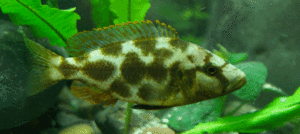Nimbochromis livingstonii facts for kids
Quick facts for kids Nimbochromis livingstonii |
|
|---|---|
 |
|
| An adult male | |
 |
|
| A juvenile | |
| Conservation status | |
| Scientific classification | |
| Synonyms | |
|
The Livingston's cichlid (scientific name: Nimbochromis livingstonii) is a cool freshwater fish. It's a type of cichlid that lives in Lake Malawi in Africa. You can also find it in the upper Shire River and Lake Malombe. These fish like to hang out in shallow areas of the lake where the bottom is sandy. They are known for a very clever way of hunting!
Contents
What's in a Name?
This fish has a special local name, kalingono, which means "sleeper." This name comes from its unique hunting style, where it pretends to be asleep or even dead.
The scientific name Nimbochromis is also interesting. It combines a Latin word meaning "cloud" with a Greek word for "chromis" (a type of fish). This "clouded chromis" name refers to the fish's unique dark, blotchy pattern on its lighter body. It looks a bit like clouds!
The specific name livingstonii likely honors Dr. David Livingstone. He was the first European explorer to discover Lake Malawi in 1856. He also collected some of the first fish specimens from the lake.
How Does the Livingston's Cichlid Look?
The Livingston's cichlid has a body that is flattened from side to side. It also has a large mouth. Male fish can grow up to about 25 centimeters (10 inches) long. Females are a bit smaller, reaching about 20 centimeters (8 inches).
Their colors can change a lot. They usually have a mix of brown and white blotches. The top fin (dorsal fin) might be blue with an orange or red stripe. Sometimes it even has a white line.
Color Changes and Camouflage
Adult males can change their colors very quickly. They might go from a spotted pattern that helps them camouflage (blend in) to bright blues and greens. They can even turn a pale golden color! When it's time to breed, males turn a very dark blue. This color almost completely hides their blotchy pattern.
The fin underneath (anal fin) is usually orange or red. Females look similar to males. However, they usually don't have the yellow "egg spot" markings on their anal fin. Young fish have a brown and white spotted pattern.
Hunting: The "Playing Dead" Trick
Wild Livingston's cichlids are amazing hunters! They have a very unique way of catching their food. They will lie still on the bottom of the lake, looking as if they are dead. Their special blotchy colors help them look like a dead fish.
They wait patiently for smaller fish to come close, thinking they've found an easy meal. When a small fish gets close enough, the Livingston's cichlid quickly lunges and swallows its prey whole! In the wild, they mostly eat small fish, especially a type called Lethrinops.
Reproduction and Life Cycle
Male Livingston's cichlids will mate with several females. After mating, the female takes care of the eggs in a special way. She holds up to 100 eggs inside her mouth! This is called mouthbrooding. She keeps them safe there until they hatch. Once the baby fish (fry) are big enough to swim on their own, she releases them.
Why Are These Fish Important?
Nimbochromis livingstonii is important to people in a couple of ways. Locally, people catch them to eat as a food fish. They are also popular in the aquarium hobby. Many people around the world keep them as pets in their fish tanks because of their interesting looks and behavior.
See also
- List of freshwater aquarium fish species


